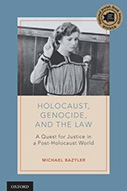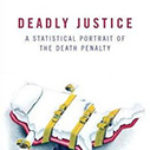Holocaust, Genocide, And The Law: A Quest For Justice In A Post-Holocaust World

Author: Michael Bazyler
Publisher: New York: Oxford University Press, 2016. 392P.
Reviewer: William R. Pruitt | March 2018
Many studies have focused on how international law was able to hold the most heinous criminals to account for their actions, or on how international law has developed since the Nuremburg trials, in International Criminal Tribunals for Yugoslavia and Rwanda. While these stories are important, they fail to account for the role that law played in allowing such genocide to occur in the first place. Bazyler discusses these important markers in history and law but also exposes how the law has been used and abused to foster and encourage genocide.
In “good” hands, the law can do what we all dream it could by holding criminals accountable regardless of status. In “bad” hands, the law can be manipulated and used to justify abhorrent behavior. Either way Bazyler offers a unique and well-thought-out analysis of the role of law in the Holocaust and in genocide more generally.
The book is divided into three sections. The first reviews the legal history leading to the Holocaust and to the United Nations Convention on Genocide. Second, the legal response to the Holocaust is explored both in its immediate aftermath and in the long term. Finally, the current state of international criminal justice is viewed through the lens of the Holocaust. Each section could be profitably read on its own, but putting them together creates a long-range view from “before genocide” to “during genocide” and lastly “after genocide.”
Bazyler wastes no time in his first chapter by explaining how within Germany the Holocaust was entirely legal. Law as an impartial arbiter of justice did not exist. The truly disturbing part here is that the law slowly evolved to secure power in only a select few and then began to disenfranchise the Jewish population. These laws not only ostracized the Jewish population but prepared the German population for what was to come in terms of isolation and ultimately extermination.
Lawyers, judges, and government employees were recruited to ensure that the extermination of the Jews was conducted pursuant to a legal process. Lawyers and judges thus played a crucial role in enabling the death machinery of the Third Reich, suggesting that the law is only as good and ethical as those people who fill the roles within it. It is easy to blame the bad people in the law, but the role that law itself plays (including international law) should be acknowledged in order to avoid repetition.
Much has been written elsewhere about the United Nations Convention on Genocide, which was developed and passed in the wake of the Holocaust. Bazyler walks through the process from Lemkin’s origination of the word to the UN language and compromises that ultimately led to the final version. For those who have not encountered this information elsewhere, this chapter is crucial; for those who are more familiar with this history, the account here offers a solid review of how early international law was created.
In part two, Bazyler examines the trials that were utilized in response to the atrocities of the Holocaust. A condensed but nonetheless thorough account of the International Military Tribunal (commonly known as the Nuremberg trial) is provided. Following the IMT were the Nuremberg Military Tribunals, which focused on lower level offenders, but made the Holocaust the centerpiece of litigation in a way that the IMT had not. The IMT thus helped establish legal accountability for war crimes, and the NMT helped establish individual responsibility for those and other crimes.
Bazyler continues by detailing the outcomes of national prosecutions after World War II. Many of these trials occurred in Germany, forcing the German people to confront their past sins and acknowledge their mistakes. These trials helped create and reinforce a collective memory inside of Germany about their behavior during the war. The importance of the Nuremberg Military Tribunals and domestic trials are too often ignored in favor of focusing on the IMT. Bazyler’s inclusion of these trials helps prove that it is impossible for anyone in Germany to claim ignorance of what happened.
The trial of Adolf Eichmann in Israel is also recounted with a focus on its effects on the development of international law. Eichmann’s trial set a precedent for universal jurisdiction—the idea that some crimes are so heinous that the defendant should face prosecution in any country regardless of whether the acts occurred there or not. Israel exercised this power to find Eichmann guilty of genocide. This trial also contributed to the idea that individuals cannot escape accountability by fleeing to another country.
Criminal prosecution can hold individuals responsible, but civil litigation can often give back to the victims. While nothing can undo the victimization, civil litigation both in Germany and outside of Germany served a sense of symbolic justice. Civil litigation is often forgotten when discussing legal responses to genocide because of the focus on criminal prosecutions. Bazyler provides an excellent discussion of the importance of civil litigation to survivors. In effect these judgments confirmed the tales of survivors and further contributed to the narrative of the Holocaust.
This symbolic justice can be important to preserving memory and offering some reconciliation to victims. After explaining how civil litigation was used in response to the Holocaust, Bazyler goes on to show how civil litigation did not work following other genocides. This discussion adds to the existing literature on whether the Holocaust is somehow unique and separate from other genocides. The failure of other survivors and victims to achieve some sense of justice via civil litigation would imply there is something special about the Holocaust.
In a similar vein, many countries in Europe have enacted legislation criminalizing the denial of the Holocaust. These Holocaust denial laws are founded on the idea of protecting the dignity of the victims and preventing a resurgence of similar atrocities. Such denial laws are prevalent in Europe especially in those nations where the Third Reich was most prevalent. At the same time, such laws raise questions about the proper limits of free speech. Bazyler provides a short summary of the debate these laws have provoked.
Recently Poland enacted a new law prohibiting anyone from attributing blame for the Holocaust to Poland, where most of the Nazi death camps were located. As such, the term “Polish death camps” has been used to refer to those extermination camps and their location. Poland’s new law would criminalize this phrase and make it an offense to imply that Poland was responsible for any of the activities in the Holocaust. Israel has claimed that this law whitewashes history by attempting to remove Poland from the equation. Poland already has a Holocaust denial law but this new law extends its scope. Laws that make it a crime to deny the occurrence of the Holocaust may, in the realm of unintended effects, make it easier to pass laws denying responsibility for the Holocaust.
Bazyler does not adhere to an all-good or all-bad position on the issue of denial laws, and instead recognizes a middle ground approach. This approach is also reliant on the law; for example, in the United States, the First Amendment protects free speech and has been interpreted to have broad coverage while the German constitution includes protection for human dignity (missing from the US Constitution). Balancing free speech against human dignity is not simple, but the balance may tip in different directions for different countries.
In the final part of the book, Bazyler examines how the Holocaust and the legal response to it sparked the growth of international criminal justice. The Nuremberg trial was a historic first—the first time individuals were held accountable in an international court for behavior affecting their own citizens. The significance of this event was not completely evident in the years following Nuremberg, when the world turned away from international tribunals. But the court at Nuremberg set new precedents in regards to ex post facto, superior/command responsibility, and the ability to claim a defense of following orders.
It was in the path created by Nuremberg that the United Nations established the International Criminal Tribunals for Yugoslavia and Rwanda in 1993 and 1994, respectively. These ICTs built upon the foundation begun at Nuremberg fifty years prior. As the ICTs worked through their caseloads new issues arose. Having multiple international courts led to inconsistent rulings and results. The slow pace of the trials and the exorbitant costs forced many to question the effectiveness of the ICTs.
In response to some of the issues raised by the ICTY and ICTR, the United Nations helped create the first-ever permanent international criminal court. The ICC represents the commitment of the nations of the world to achieve justice for those crimes that are abhorrent by their nature—genocide, crimes against humanity, and war crimes. This court reflects an attempt to tell the world that no one is immune from prosecution for these offenses. Symbolically, a conviction “by an international tribunal carries a stronger message of revulsion and rejection of impunity than a conviction by a domestic court” (p. 263). The ICC would not exist but for the precedent set by the Nuremberg trials.
Many books on genocide include a chapter on prevention, and Bazyler’s is no different. He concludes by asking the question that has been asked since 1945: can genocide be prevented? Sadly, looking at history, the answer would appear to be no. Regardless of the importance of Nuremberg, of the victims, or of the desire to rid the world of genocide, the answer lies not solely within the realm of law. Law, as an entity, has little effect on crime. The law tells us what is forbidden and what the punishment is for a violation, but the law has rarely been seen to stop crime from occurring. There seems little reason to think that law can do better in preventing genocide if it is incapable of preventing a purse-snatching. As Bayler notes: “lack of law is not the problem” (p. 290).
The prevention of genocide requires much more than the law; it requires engaged politicians, it requires commitment to act, it requires courage. In too many instances the nations of the world have shown that they lack all of the above. Like other scholars who examine genocide prevention, Bazyler argues that the prevention of genocide may require early intervention including military intervention. This is likely to occur only when the nations of the world are willing to put force behind the lofty ideal of “Never Again.”
To summarize, this book should be read by every lawyer or social scientist working on issues of genocide, genocide-prevention, or international criminal law. Those who are interested in the role that law itself has played in fomenting genocide should also read this very comprehensive and approachable text.
William R. Pruitt, J.D., Ph.D., Assistant Professor of Criminal Justice, Virginia Wesleyan University


